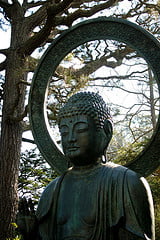In this video and article, you are going to learn how to practice mindfulness meditation using a couple of different approaches. You will also learn what mindfulness is, or at least you’ll get a new perspective on it if you already have knowledge of the subject.
Either way, you will understand all the little nuts and bolts that mindfulness meditation is made of.
The ego is the thinker and feeler, not you. It is the “it” that is thinking. The “you” is your true self, the observer. The ocean. The sky. However you do your practice, keep this in mind. The realization of this true self will become deeper the more you practice mindfulness meditation.
You can scroll down just a little bit and watch the video. You can also hit the play button and then scroll past the video so you can read along with my voice.
First, we need to be clear on what mindfulness is. There are two common definitions.
One definition of mindfulness is to pay attention to what you are doing. In this sense, when you are brushing your teeth, you’re paying full attention to the feeling of brushing your teeth and the flavor of the toothpaste, etc. You are brushing your teeth mindfully.
The other definition of mindfulness is the one we are using in mindfulness meditation practice. It is to be impartially present with moment to moment experience as it arises into consciousness. This includes thoughts, emotions, feelings of boredom, antsy feelings and more.
The ego pushes away uncomfortable experience and clings to the comfortable and the familiar. It will actually bury what it doesn’t want to face or feel. Think of the extreme case of PTSD. It’s the same process. Mindfulness practice is the opposite of that process.

The two definitions are actually quite similar. The second can be thought of as an extension of the first.
Everything you do and all your thoughts are processes happening in the moment. Mindfulness is the practice of nonresistance to what is happening now. It is also the practice of not clinging to it either. It’s about nonjudgmental observation.
Mindfulness meditation practice usually begins with an object of focus. One of the more popular objects is the breath. In this case, you focus on the breath and become deeply absorbed in the feeling of the breath. You can control the breath by breathing deeply or just simply watch the breath as it happens naturally.
The mindfulness part of the practice comes in whenever something distracts you from your object, which is the breath in this case.
In some Buddhist traditions, they teach you the art of “noting”. If a thought happens, you don’t try to get rid of it or hold onto the breath. You “note” it as it happens in the present moment. The thought is not a bad thing, and it’s not a good thing. It just is. After noting and being cool with the thought being there, go back to the breath.
In addition to noting, some traditions teach you to label what is happening. You can mentally say to yourself “thinking” to register in your mind that thinking is happening in the present moment. If you feel anger, say “anger”. If you feel worry, say “worry”. If restless feelings distract you from your object, say “restless”. If you feel tension, say “tension”.
After noting and/or labeling, go back to your breath or your chosen object.
Regardless of how you note or label, there are different ways to practice mindfulness meditation. One method is exactly the practice described above. You note the distraction as an impartial observer and then go back to the object.
Another way to practice mindfulness is to hang out with the thought, feeling or emotion a little bit longer. Hang out with it and observe it. Appreciate it. Don’t cling to it or push it away. You can use labeling if you wish.
The thought or emotion could vanish fully or partially because mindfulness and impartial observation cause it to lose power over you. After you’ve made friends with it, go back to the breath or whatever your chosen meditation object is.
Notice that thoughts often have a sensation associated with them. It may be a feeling in the head or elsewhere. When observing a thought, be sure to pay attention to this feeling as well.
The only difference between the two approaches is the length of time you hang out with the thought, feeling or emotion.
There is one other mindfulness method that some people teach. In this practice, you simply allow the thought, feeling or emotion to coexist with your meditation object. You still focus on the object without judging what else is happening. These things will just rise and fall naturally. Sometimes they will have a bigger hold on you, and sometimes they will have a lesser hold on you or none at all.
This is like the first type of mindfulness practice, but the noting isn’t quite as pronounced. The acknowledgement of thought is still there. There’s no pronounced pause from the object either.
In most situations, I usually recommend one or both of the first two methods.
Whatever style you use, keep focusing on your meditation object. Some thoughts are going to be really sticky or enticing. Your brain REALLY wants you to stop concentrating. Instead of a thought, it could be a really strong feeling that you just don’t want to be here now.
In such a case, you may want to just drop your object for a little bit longer than usual and just sit with the thought or feeling. Try to be as nonjudgmental as you can and face it. The less judgmental you are, the less power it has over you.
Meditation objects vary a lot. Some people repeat a mantra, a word or a phrase, silently or aloud. Others use a visualized image. For more info on meditation objects, see The Different Types of Meditation Techniques and How to Choose One.
In this case, you’re still playing the impartial observer. You are the sky. They are the clouds. You are the entire ocean and they are just waves, rising and falling.
Not everyone uses an object in mindfulness practice. Open inquiry meditation is a mindfulness technique during which you impartially observe whatever comes up. A thought may arise and fall away. It will keep your attention as long as it has to until something else becomes “louder”. Then the attention may go to a feeling of tension in the body, then to another thought.
Some people practice a variation of mindfulness practice whenever they can during the daily routine. When washing dishes, they are watching thought. When shopping, they are watching thought.
One way to make mindfulness practice easier is to change your perspective and how you think of yourself.
You know how to practice mindfulness now. Try it and share your opinions or experiences in the comment form below.
Tom Von Deck is a meditation trainer, speaker, and speaker. Tom specializes in making meditation much much easier for busy and non-busy people from all backgrounds and paths. He is the Mackdaddy of The Deeper Meditation Video Zone and DeeperMeditation.net.


8 comments
Bhagwan
last evening when I cludon’t sleep right a way I waited for my breath to be balanced and then I tried to breath from this area .. breathing was very hard and with effort and it took quite a while until it got easier and better .. but it felt released afterwards everything lighter and easier inside .. Swamiji, can you tell from my memory whether I spoted the right area?
Bonnie Hardy
WOW !!!!!You have helped me more in 15 minutes than anyone…
Thank you for sharing your knowledge….
Simeon
Thanks for this useful resources, great site.
Carlos
Mindfulness meditation has been very helpful for a beginer like me Tankyou Tom